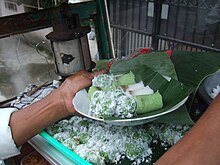 | |
| Type | Snack |
|---|---|
| Place of origin | Indonesia[1][2] |
| Region or state | Java Sulawesi (southern) |
| Associated cuisine | Indonesia |
| Main ingredients | Rice cake, palm sugar (gula jawa/merah), grated coconut |
| Variations | Rainbow klepon |
| Similar dishes | bua loi, mont lone yay baw, Khanom tom, tangyuan, modak, Buah melaka (Kuih) |
Klepon or kelepon, also known outside Java as is a sweet rice cake ball filled with molten palm sugar and coated in grated coconut.[3] Of Javanese origin,[4] the green-coloured glutinous rice balls are one of the popular traditional kue in Indonesian cuisine.[1][4]
Klepon is a boiled rice cake filled with liquid palm sugar (gula jawa/merah) and coated in flaked coconut.[3] The dough is made from glutinous rice flour, sometimes mixed with tapioca, and a paste made from the leaves of the pandan or dracaena plants (daun suji) — whose leaves are used widely in Southeast Asian cooking — giving the dough its green colour.[2]
The small pieces of palm sugar are initially solid when inserted into the glutinous rice dough and rolled into balls. The balls are subsequently boiled, which melts the palm sugar and creates a sweet liquid inside the balls' cores. Skill is involved in ensuring that the liquid does not leak out of the final product. The balls are finally rolled in shredded coconut, adhering to the sticky surface of the glutinous rice dough.[5]
Klepon are ideally left to cool for some time before consumption to prevent burning from the hot liquid palm sugar. They are traditionally served in banana leaves, usually in sets of four or ten balls; plastic packaging is also used in recent times.

Klepon, meaning 'animal's ovary', is the Javanese name for this kue.[4] In other parts of Indonesia, such as in Sulawesi, Minangkabau region in West Sumatra,[6] and in neighbouring Malaysia, it is mainly known as onde-onde. In Java, onde-onde refers to the Chinese jian dui, a rice cake ball coated with sesame seeds and filled with sweet green bean paste. Although popular in Indonesia and neighboring areas, klepon originated in Java.[1][2]
The dish is also called klepon in the Netherlands, due to its colonial ties with Java. In the 1950s, klepon was introduced to the Netherlands by Indo immigrants and is readily available throughout the country in toko shops, Dutch or Chinese Indonesian restaurants, and supermarkets.[7]
In Java, klepon, along with getuk and cenil, are often eaten as morning or afternoon snacks. They are categorised as jajan pasar (market snacks) in traditional markets and villages and kue basah (moist kue) in urban areas due to Chinese influence in naming.[8]

Traditional klepon is quite homogeneous in Indonesia, new recipes have been developed: some modern variants replace the rice flour with yam or sweet potato (Indonesian: ubi) dough,[9] the liquid palm sugar filling with chocolate,[10] or the grated coconut with grated cheddar cheese.[11] Colourful klepon has also been created using potato-based dough and food colouring to make it more appealing to children.[12]
Klepon is quite similar to Kue putu, with the difference in its shape, texture and the flour being used — klepon uses glutinous rice flour, while kue putu uses common rice flour. Klepon has somewhat a chewy sticky texture similar to mochi, and kue putu has a soft yet crumbly texture akin to cake. Klepon is spherical, while kue putu is tubular, shaped using a hollow bamboo tube.
Cupcakes using onde onde ingredients are another recent variation on the dish.[13]
The Indian dish paan ladoo resembles klepon, but uses betel leaves (paan) instead of pandan.